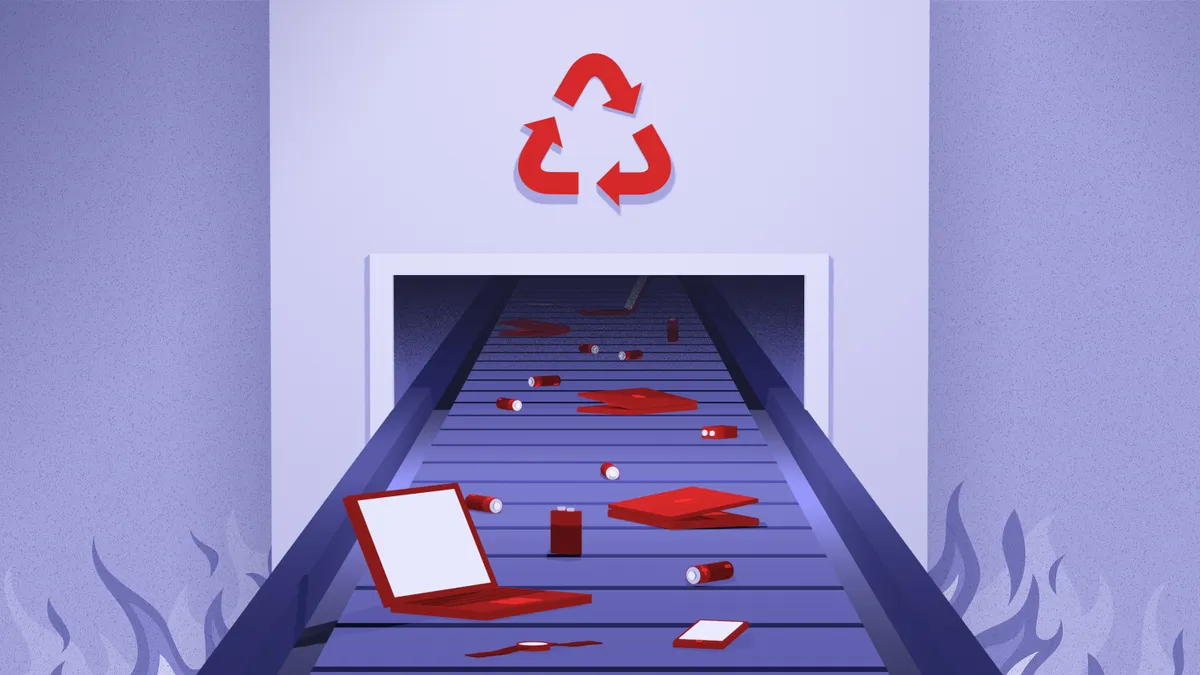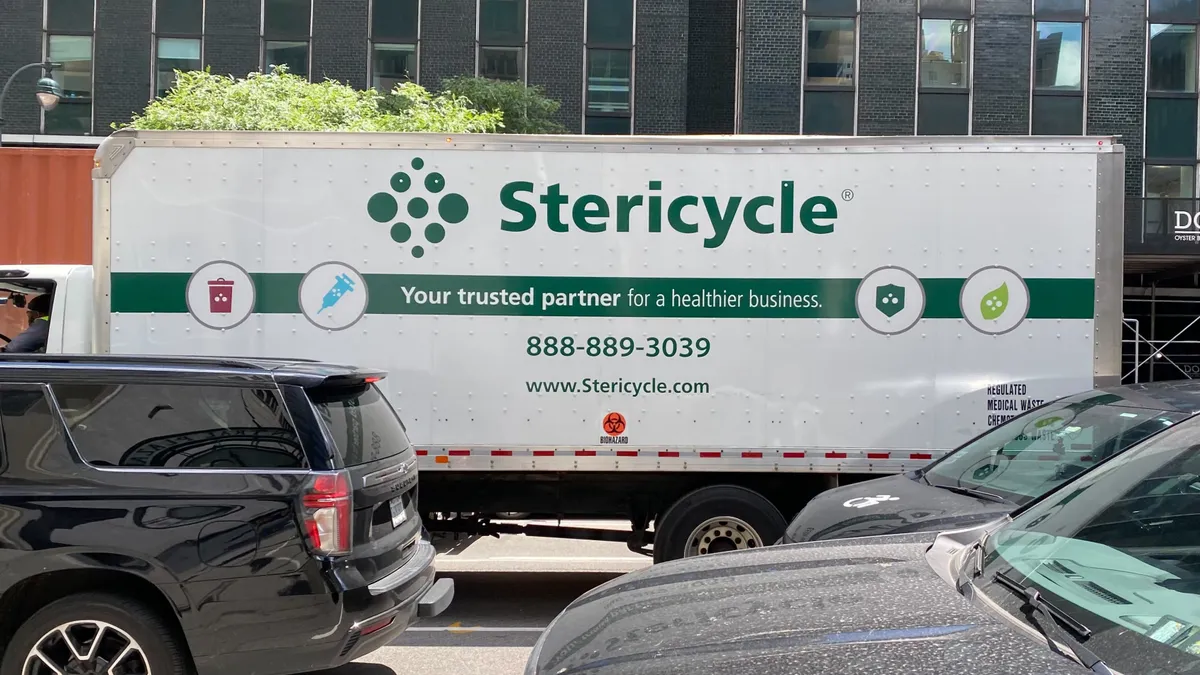It's nearly impossible to scan a modern home and not spot electronic devices with lithium-based batteries. From smartphones, watches and fitness trackers, to toothbrushes and toys, they are increasingly the power source of choice. Those batteries are also increasingly found in the waste stream where they can create significant hazards.
"There's definitely a correlation in the rise of these batteries showing up in the waste stream and catastrophic fires occurring," Jesse Maxwell, the Solid Waste Association of North America's (SWANA) advocacy and safety manager, told Waste Dive.
Concerns around safety and sustainability — especially in light of virgin resource shortages — have prompted a recent push for more responsible lithium battery recycling solutions in the U.S. But trying to keep up with the rapidly evolving electronics sector is difficult.
Ongoing developments with battery chemistry could render some forms of recycling obsolete soon after implementation. Plus, lithium-ion (Li-ion) batteries are used in a multitude of devices — including large products such as electric vehicles — and come in a variety of forms. The differing types and internal components add to the complexity of devising widely applicable battery safety and recycling solutions.
At the same time, industry professionals say waiting for a long-term, mainstream lithium battery recycling solution to transform the industry is not a viable option. Facility operators must be proactive with implementing battery safety policies and training — including plans for recycling — to avoid fire damage, worker injuries or other negative consequences.
"Every MRF has to have become aware of the issues associated with this particular waste hazard by now," said Carl Smith, president and CEO of the nonprofit Call2Recycle battery recycling and stewardship program.
Hashing out hazards
Lithium-based batteries come in many forms, and all are problematic for waste and recycling facilities, but Li-ion tend to pack a greater power punch and garner more attention. Lithium batteries are not considered dangerous when used in ideal conditions, but they are damaged easily and can spark fires.
While some EV batteries are among the types housed in a robust protective casing, many lithium-based battery cases are thin and subject to damage from even small amounts of pressure. Obvious signs of damage include punctures, chemical leaks or swelling. A good portion of battery damage, such as when reactive chemicals mix with each other, occurs inside the case and can go undetected until a thermal event occurs.
Battery fires can spark simply from the jostling a device sustains inside a collection truck or at a MRF. A high-profile 2017 fire that was caught on video at ecomaine, in Portland, Maine, shows a material pile smoldering and sparking flames just moments after being deposited at the facility. A missed battery in the load was cited as the cause.
The rapid evolution of consumer electronics and batteries has been challenging for the recycling industry, with issues growing worse. According to Call2Recycle's Smith, "there are many, many, many more of them" in use today than just a few years ago.
Another major safety issue is the energy density, or power per weight, associated with lithium batteries has increased substantially. Manufacturers are also incorporating more hidden batteries into their products, making it difficult or impossible to safely harvest the units for recycling. Integrated batteries are less likely to have hard outer cases to minimize puncture impact, raising further safety issues. This trend can limit potential for electronics refurbishment or reuse, thus preventing a leading option for responsible device end-of-life management.
Combating the problems
While the difficulties of lithium batteries are becoming well-known, the solutions are still emerging. Remedies broadly fall into two categories: operational changes and education.
Presently, operational changes are the main way to prevent lithium-based battery dangers. Haulers and facility employees are being trained to spot the items early and remove them for safe storage when possible.
The units should be stored separately from flammable materials, such as paper, and the terminals must be insulated or taped to prevent interaction with other batteries. Typically, MRFs store lithium-based batteries in drums or bulk containers and they are shipped as Class 9 hazardous materials.
Training programs are available through sources including battery recycling businesses, industry organizations and safety advocacy groups. This year the EPA and U.S. Department of Transportation conducted free lithium battery safety training sessions across the country for industry participants.
This type of education, including what to do if a fire sparks, is what Call2Recycle's Smith views as "the most significant thing anybody can do, no matter where they are in the supply chain."
Partially spurred by this issue, it's becoming more common to see businesses install enhanced fire detection and suppressant equipment at their facilities. Companies including Fire Rover offer an expanding array of early fire detection technologies that catch hot spots before they escalate. Facility upgrades also include modern fire suppressant systems that employ alternate extinguishing agents, because water exacerbates lithium fires.
"A lot of them are exploring more robust technologies for catching and fighting fires earlier in the process," said SWANA's Maxwell. "I think we’ll see more of a focus on technology going forward."
The severity of the problem is also inspiring further research from environmental and industry groups. SWANA recently released a report with guidelines to minimize fire risk and damage, highlighting challenges from "new types of discarded products such as lithium-ion batteries."
The Environmental Research and Education Foundation has also partnered with the Institute of Scrap Recycling Industries’ Paper Stock Industries chapter to examine Li-ion batteries' role in fires and potential policy or operational changes. The groups are studying issues related to fires in collection vehicles, MRFs and other facilities. Results and recommendations will be released soon.
Education also doesn’t end within the borders of the waste and recycling industry. The public’s lack of knowledge on the issue leads to a lot of batteries improperly ending up in the waste stream and causing dangerous situations.
Facilities themselves should be a primary source for battery safety messaging, say industry participants. For example, ecomaine released video of the 2017 fire to underscore the importance of keeping lithium batteries out of the waste stream.
"MRFs and the local municipalities that are in charge of these programs are on the frontline of where the education has to come from," said Paul Johnson, executive director of environmental affairs at Kinsbursky Brothers Inc. (KBI), a battery and catalytic converter recycling business.
Since consumers aren't experts on battery types, and which ones pose an especially high fire risk, SWANA's Maxwell said the best messaging addresses safe battery handling in general. While drop-off recycling programs aren't often seen as convenient for consumers, greater education could potentially make them rethink their behavior.
"Public education plays a role in making sure that at least the consumer knows a battery can be recycled in a certain way," said Steve Christensen, executive director of the Responsible Battery Coalition, a group dedicated to responsible vehicle battery manufacturing, use and reuse.
Although his group primarily focuses on lead-acid batteries, like those in gas-powered vehicles, Christensen says there are similarities among the safety, education, collection and reuse principles with lithium-based batteries.
"I don't think that on the technical level the folks who are recycling next generation lithium-ion batteries are looking at lead-acid and saying, 'What are these guys doing that can help us?' The processes are quite different," he said. "But there is a lot of communication and coordination."
The 99% recycling rate for lead-acid batteries in the United States is among the highest of any material, suggesting that programs for certain types of lithium batteries eventually could gain similar traction.
Reuse and recycle
MRFs are aware of the issues associated with lithium batteries, and many have implemented the suggested precautionary measures, but it's often still unclear what do with the batteries being recovered.
"If they locate them, they can package and ship them," KBI's Johnson said. "There are recycling options."
Businesses and nonprofits, including KBI and Call2Recycle, facilitate the movement of numerous types of batteries down the recycling chain. Other businesses, such as Spiers New Technologies, center on repurposing and recycling EV battery packs. Thus far, the most prominent option for Li-ion vehicle batteries is to repurpose them for energy grid storage.
Yet lithium battery recycling still isn't widely viewed as a profitable business model and not many recyclers have delved into this nascent sector.
"The success of a recycling program is directly related to the intrinsic value of the battery," Johnson said. "There are many sub-chemistries for lithium-based batteries [and] some of them have intrinsic value, some of them do not."
That issue is broadly regarded as the primary thing limiting lithium-based battery recycling. Interested entrepreneurs usually come back to one key question when weighing whether to invest in a venture, said EnZinc President Michael Burz: "'Can I make money?' The short answer is, not yet you can't."
Recycling disparities also exist between the small lithium batteries in consumer electronics and those in EVs.
"There are currently ways to recycle consumer electronics batteries profitably. The issue is their collection rates are really low. It's a different story with electric vehicles," said Jeff Spangenberger, director of the ReCell Center. He said EV battery collection is on the rise because of the potential for energy storage, but recycling them is also still not a profitable venture.
The U.S. Department of Energy (DOE) launched the ReCell Center this year specifically to find solutions for Li-ion battery recycling. This consortium of research and development teams from several national laboratories aims to develop new methods to separate, reclaim and reuse materials from Li-ion batteries safely and profitably, thus accelerating market growth.
However, the ReCell Center can’t enhance these markets alone. "If industry isn't involved, this won't work. It doesn't make sense to do this work unless industry is held very closely," Spangenberger said.
DOE also launched a $5.5 million phased prize competition to incentivize the development of processes to profitably capture 90% of discarded Li-ion batteries for material recovery. SWANA is among the groups that assisted DOE with judging the competition.
Numerous recycling industry participants and member associations express a willingness to work with these groups. They would also like lithium battery manufacturers to play a greater role in the safe disposal, reuse and recycling of their own products.
Still, with frequent changes occurring in battery make-up, "lithium chemistry may not even be predominant 15 years from now," said the Responsible Battery Coalition's Christensen.
That shift to safer, non-lithium battery chemistries is a goal for businesses such as EnZinc. The company is now working to create high-performance, rechargeable, non-flammable batteries comprised mainly of zinc to compete with Li-ion.
"They have the energy of lithium ion, they are as cheap as lead-acid, but they are safer than both of them," and they are recyclable, Burz said.
EnZinc’s batteries remain in the development and testing phases, and the company hopes to make them available in about two years.
This R&D measure, along with others seeking Li-ion alternatives, is perceived as a good start toward keeping workers safer. But with lithium batteries likely to continue dominating the market, many say the waste and recycling industry must remain focused on figuring out how to promote safe management practices — at least in the near term.



















